Main Second Level Navigation
Breadcrumbs
- Home
- About Us
- Our History
- Early History of Ophthalmology in Toronto
Early History of Ophthalmology in Toronto
A comprehensive review of the first ophthalmologists in Toronto provides insight into their unquestionable dedication. They are notable not only for their contributions to the advancement of medicine and ophthalmology, but also for significant contributions to science, engineering, education, social justice and welfare, and art.
Samuel John Stratford founded the first eye hospital in Toronto.
William Rawlins Beaumont, the first to perform eye surgery in Toronto, was an internationally recognized innovator, constantly looking to improve surgical techniques through the development of new instruments.
Abner Mulholland Rosebrugh, the first to exclusively practice ophthalmology in Toronto, was a true inventor, pioneering ophthalmoscopy and telephonics. Rosebrugh was also dedicated to social welfare and headed a commission that led to the creation of the Toronto Children's Aid Society.
George Sterling Ryerson, a decorated military man, founded the Ontario St John Ambulance Association and the Canadian Red Cross.
Richard Andrew Reeve, the first Chair of the Department of Ophthalmology at the University of Toronto, was internationally recognized as a founding Canadian ophthalmologist and presided over both British and Canadian Medical Associations.
James Metcalfe MacCallum, the second Chair of the department, was an active member of the Medical Council of Canada and presented the first paper on establishing standard training requirements in medicine. MacCallum also initiated harm reduction concepts in drugs and addiction, and was a Patron of the members of the Group of Seven and Thomas John Thomson.
Walter Walker Wright, the fourth Chair of the department, organized the first modern ophthalmology residency training program in Canada. A pioneer in pediatric surgery, Wright developed surgical instruments and procedures still used today.
These physicians all published in local and international medical journals throughout their careers. The dedication of these historic figures to both medicine and society is a source of inspiration for the modern ophthalmologist.
Samuel John Stratford (1802-1871)
Samuel John Stratford was born in England in 1802 and trained at St. George's and Westminster Hospitals in London as a student of George James Guthrie (1785-1856), founder of the Royal Westminster Ophthalmic Hospital. In 1828, prior to moving to Canada, Stratford published "a Manual of the Anatomy, Physiology and Diseases of the Eye and its Appendages," a book well received by the medical community and praised in the Lancet.
Stratford emigrated to Canada in 1830 and began a medical practice in Bytown (Ottawa) in 1831, where he was responsible for the Bytown Military Hospital during the cholera epidemic of 1832. In 1835, Stratford moved to Woodstock, Ontario, after receiving a land grant of 200 acres in Zorra Township from Sir John Colborne, the Lieutenant-Governor of Upper Canada. He was appointed a member of the Medical Board of Upper Canada in 1838 and practiced in Woodstock for 20 years.
Stratford moved to Toronto in 1850 as an established surgeon and oculist and practiced there for 10 years. He lectured on anatomy at the medical department of Victoria University in Toronto, known as "Rolph's School". He also established the first eye hospital in Toronto, the Toronto Dispensary for Disease of the Eye, at the corner of King St and Church St.
Stratford was controversially outspoken about many subjects including the two competing medical schools in Toronto, and called for a merger of the institutions. As editor of the Upper Canada Medical Journal of Medical, Surgical and Physical Science, Stratford had a prolonged dispute with Beaumont over the journals' publications. In 1854, one year after becoming editor, the journal ceased publication and in 1855 Stratford left Toronto. He did not return to Woodstock, as stated in several documents, rather he moved to Aukland, New Zealand, where he practiced until his death in 1871.
William Rawlins Beaumont (1803-1875)
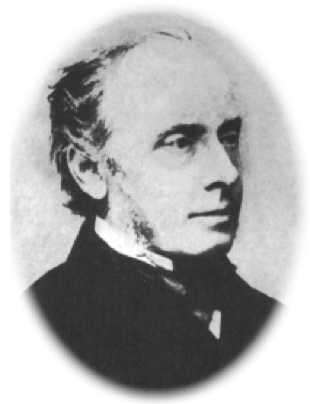
William Rawlins Beaumont is the first physician on record to perform eye surgery in Toronto. Beaumont was born in 1803 in London and studied with English surgeons John Abernethy (1764-1831) and Sir Astley Cooper (1768-1841) at St. Bartholomew's. He was elected a Member of the Royal College of Surgeons of England in 1826, and a Fellow in 1836. At Bartholomew's he became great friends with then-student James Paget (1814-1899), who would praise Beaumont's surgical inventions.
Before moving to Canada, Beaumont invented an instrument to sew together the edges of vesico- and recto-vaginal fistulae. This design is claimed to be the origin of the Singer sewing machine, first seen by Isaac Merritt Singer (1811-1875) in a surgical instrument maker shop in New York in the early 1800s.
Beaumont also invented instruments for passing sutures in "deep-seated parts" for cleft palates; a lithotomy knife; a speculum; an instrument to tie polyps; and iris forceps. He authored several essays on fractures, tumors, vascular aneurysms, and penetrating orbital injuries, and was considered an international contributor to surgery and medicine.
In 1841, Beaumont moved to Ontario from London, England. He was granted a license to practice from the Upper Canada Medical Board in November 1842. Beaumont was appointed the first Professor of Surgery at the University of King's College, in 1843, the first medical school of Upper Canada. At the time 20 physicians worked in Toronto serving a population of 15,000.
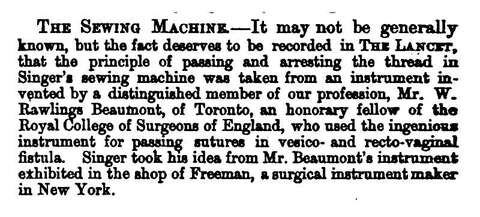
In December 1851 Beaumont described and published the results of 13 complicated ophthalmic surgeries successfully performed in the 1840s, and became known in Toronto as a leading eye surgeon. On October 25th 1844 Beaumont recorded the details of a cataract surgeryhe performed using an instrument designed by Austrian ophthalmologist George Joseph Beer (1763-1821):
"I operated by extraction, making with Beer's knife a section of the cornea, forming a flap of its outer and inferior half about one twentieth of an inch from the sclerotica," he recalled. "The pupil being well dilated, I passed the point of the knife through it, and opened the capsule at the same time that I made the section of the cornea, on the completion of which, the lens very soft and broken in pieces, was expelled with a small quantity of vitreous matter."
Beaumont used Belladonna to achieve pupil dilatation preoperatively. Three days later Beaumont described the patient's eye to be "very little inflamed, and the wound in the cornea apparently healed."
Beaumont also designed a pair of sliding iris forceps that would draw iris through a corneal wound without damaging the cornea. He published his description of these forceps in the Medico-Chirurgical Transaction in 1863, describing two cases in which they were used. Beaumont was elected a member of the Société Universelle D'Ophthalmologie in 1861 for his contribution to cataract surgery. His sliding iris forceps were placed in the museum of the Royal College of Surgeons in London.
Beaumont lost the vision in his left eye in 1865 to a chronic inflammatory condition thought to be glaucoma, which began to affect the vision in his right eye by 1871. He retired in 1873 and died in Toronto at age 72 in October 1875.
Abner Mulholland Rosebrugh (1835-1914)
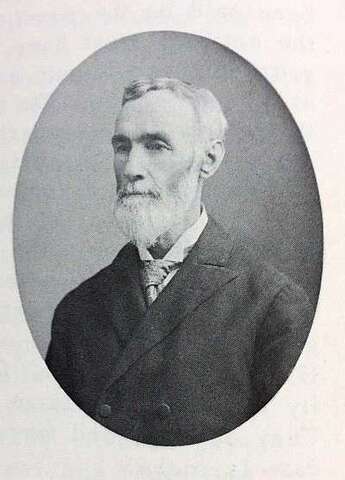
Rosebrugh was interested in inventions in and outside of ophthalmology. In 1864, he designed the first ophthalmoscope with which one could photograph the fundus of a living eye. He tested the device on animal subjects and described at length its design, its optical principles and his experiments:
"As yet I have not attempted a photograph of the retina of the human eye, but have confined my experiments to the lower animals, and I have used solar light only in order to shorten the time as much as possible . . . In photographing the eye of a cat, I found it necessary to put it under the influence of chloroform, but the image of the optic nerve, vessels, etc., upon the ground glass is so very bright and clear that I do not doubt if the most sensitive process be adopted, the impression could be taken instantaneously, thus rendering anaesthesia unnecessary."
Rosebrugh worked with the optician and instrument maker Charles Potter (1831-1899) at 20 King Street East, and made a photographic ophthalmoscope available for 10 dollars. Rosebrugh made a plea to his colleagues to adopt the instrument as freely as they would a stethoscope. An editorial in the 1864 Buffalo Medical and Surgical Journal praises Rosebrugh's instrument in its ability to both be adopted as a camera obscura, where the image of the fundus is projected, and to make photographs using prepared photographic plates. They conclude that it will "aid in banishing from ophthalmic nomenclature the indefinite term of amaurosis, where, as Walther observed, 'the patient sees nothing, and the surgeon likewise – nothing.'"
23 years later Rosebrugh published an Original Communication in The Canadian Practitioner describing his experiences using the photographic ophthalmoscope on humans and the mechanism of his device, with a detailed diagram of the camera tube.
A reference to a Toronto physician's creation of the first fundus camera is recognized in the American Academy of Ophthalmology's commissioned book, The History of Ophthalmology, though Rosebrugh's name is not acknowledged.
Rosebrugh and Potter worked together on several other inventions. In an advertisement in the December 1887 edition of The Canadian Practitioner, Rosebrugh promotes a medical battery, used in the treatment of nervous and chronic pain disorders, named "The Rosebrugh Improved Constant Current" available for purchase through Charles Potter.
More notably, Rosebrugh invented and patented a method for transmitting telephonic and telegraphic messages on the same wire, called duplex telephony. In January 1887 he described duplex telephony at length to the members of the Canadian Institute. He sold the patent rights to the Bell Telephone Company of Canada. Rosebrugh was a close friend of Graham Bell and helped him in the development of the telephone. Rosebrugh held six patents relating to the improvement of telephones and is said to have had the first telephone in Toronto.
Rosebrugh contributed greatly to the ophthalmic education of medical students at both the Toronto School of Medicine and the medical department of Victoria University. A series of his lectures on diseases of the eye were subsequently published in the Canadian Medical Journal of Montreal in 1866 for the benefit of physicians practicing throughout Canada. In his series he covered the principles and management of "optical defects of the eye" and the treatment of hypermetropia, myopia and presbyopia with lenses. In his lecture he states:
"There is an optical defect of the eye that is occasionally met with called astigmatism in which the horizontal and vertical lines are not brought to a focus at the same distance behind the lens. I have seen but one case."
He also described "convergent strabismus" and stated the treatment was with convex lenses.
Rosebrugh understood and taught the optics of refraction and accommodation well before it was common practice. His lecture series occurred only one year after the first major textbook of clinical optics by Franciscus Cornelis Donders (1818-1889) was published in 1864.
Outside of his medical and scientific endeavours, Rosebrugh was dedicated to social welfare. In 1890 he was appointed to a Royal Commission on the Prison and Reformatory System of Ontario. The commission revealed that poor and neglected children were frequently involved in the reformatory system. They recommended an association be established to look after the needs of homeless and vulnerable children in Toronto. This ultimately led to the creation of the Toronto Children's Aid Society.
Rosebrugh died in Toronto aged 79 in 1914.
Richard Andrew Reeve (1842-1919)

Reeve was born in Toronto in 1842. He studied at the University of Toronto and then received his medical training in Kingston, Ontario at Queen's College. He worked as assistant surgeon at the Toronto Eye and Ear Infirmary from 1867 until 1872 and then became the first ophthalmic and aural surgeon at Toronto General Hospital. He was the first specialist in any field at that hospital. [44,45]
Reeve taught first at the Toronto School of Medicine in 1872. In 1887, after the establishment of the University of Toronto Medical School, Reeve was appointed professor of ophthalmology, otology, rhinology and laryngology. In 1896 he was elected dean of the Faculty of Medicine at Toronto University, a position he held for the next 12 years. During his tenure, the first female student was admitted to the medical school; he founded an alumni association; and he pushed for the building of Convocation Hall. [7,46]
In 1906 he became president of the British Medical Association. He was also president of the Canadian Medical Association. He was a Foundation Fellow of the American College of Surgeons. He published widely in both Canadian and American journals on topics such as the use of cocaine in anaesthesia [47] and plastic surgery procedures for the eyelids [48].
Reeve retired from the university in 1914. He stayed active in the medical community and died suddenly in 1919 while walking home. Reeve was described in an obituary by one of Canada's most distinguished ophthalmologists Frederick T Tooke (1873-1955) as being one of Canada's few founding ophthalmologists, along with Frank Buller of Montreal [46].
Frank Buller (1844-1905)
Frank Buller, a member of a well-known Devonshire family, completed his medical studies at the Rolf School of Medicine, Victoria College in Toronto in 1868. He then traveled to Germany to study with the pioneering ophthalmologist Frederich Wilhelm Ernest Albrecht Von Graefe (1828-1870). He studied pathology under Rudolf Ludwig Karl Virchow (1821-1902) and optics under Hermann Ludwig Ferdinand von Helmholtz (1821-1894). In 1872 he moved to London, England, and became House Surgeon at the Royal London (Moorfields) Ophthalmic Hospital . He became a member of the Royal College of Surgeons and then moved to Montreal to become the first ophthalmic surgeon in the city; the first Professor of Ophthalmology at McGill University; and the first ophthalmic surgeon to the General Hospital. In 1895 he moved to the new ophthalmic clinic of the Royal Victoria Hospital in Montreal.
Buller was a colleague of Sir William Osler and a teacher to Harvey Cushing. He is said to have taken the Montreal specialist position in ophthalmology in place of Osler, who was interested in the specialty at that time. Osler instead continued developing his career in general medicine. Osler also resided with Buller at 1351 St Catherine Street, Montreal, renting a room and office on the second floor.
Buller is known internationally as the founder of modern ophthalmology in Canada. He is credited with bringing asepsis and antisepsis to Montreal. He is also credited with bringing the ophthalmoscope, refraction and modern eye pathology to Canada. He invented the Buller Shield , a popular device in the late 19th and early 20th Century . Buller wrote 76 papers and published on a diversity of ophthalmic topics featuring prominently in pathology. Buller died of pernicious anemia in Montreal in 1905.
George Sterling Ryerson (1855-1925)

Ryerson enlisted in the militia at the age of 15 and became assistant surgeon to the 10th Battalion of Infantry during the North West rebellion of 1885 in Saskatchewan. He dedicated much of his career to the Canadian military and was promoted throughout the late 1890s for his efforts. He was named honorary surgeon-general in 1915 and then honorary colonel of the Canadian Army Medical Corps in 1917.[39]
Ryerson founded the St John Ambulance Association in Ontario in 1895 and the Canadian Red Cross in 1896.
Ryerson recognized the importance of colour vision and helped to initiate mandatory testing in railway employees. He published details on rates of colour blindness in European and North American countries. [40] He was the first in Toronto to use cocaine topical anesthesia for eye procedures [7]. In 1911 he published in the CMAJ an address given to the American Association of Ophthalmology and Otolaryngology on the use of radium in ophthalmology to treat rodent ulcers, angiomas and epitheliomas of the lids and conjunctiva; sarcoma of the eye lid; trachoma and lupus of the conjunctiva and tuberculosis of the iris; and to relieve pain secondary to chronic uveitis. [41]
Ryerson retired from medicine in 1920 to Niagara-on-the-Lake where he wrote a memoir, Looking Backward, published in 1924 by Ryerson Press [42]. He died in Toronto of a heart attack aged 70 in 1925.
James Metcalfe MacCallum (1860-1943)
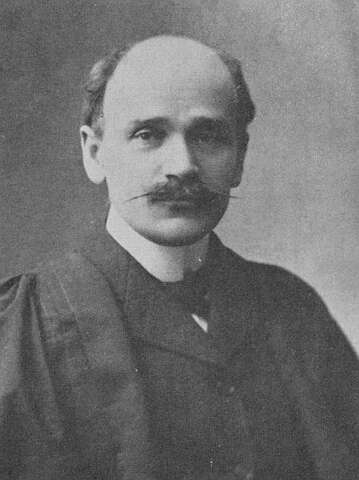
MacCallum received his BA and a gold medal from University College in 1881 and completed his medical degree from Victoria University in Toronto in 1886. He studied ophthalmology in London for two years and then returned to Toronto to practice. He returned to London and Berlin for further postgraduate studies and in 1903 was appointed associate professor in the Department of Ophthalmology at the University of Toronto. He was promoted to full professor in 1909. He became the second Chair of the department from 1914 until his retirement in 1929. [7,44] MacCallum worked primarily at the Toronto General Hospital but also retained a staff position at the Hospital for Sick Children. MacCallum's ophthalmology publications include a case of recurrent swelling of the eyelids [51]; a case of exophthalmos in a neonate [52]; and the effect of artificial light upon the eye [53].
MacCallum represented the University of Toronto at the first meeting of the Medical Council of Canada in 1912. He was an active member of the council and became president in 1923. He also represented the University on the Council of the College of Physicians and Surgeons of Ontario from 1909 until 1930. In 1924, MacCallum presented the first paper on licensure to the Canadian Medical Association proposing "interprovincial reciprocity on the basis of uniform standards and accreditation by the Medical Council of Canada." [50] He recommended a minimum of five years of medical study including three years of clinical training.
MacCallum was progressive in the area of drugs and addiction. He lobbied for government control where addicts could be registered and supervised by a druggist, an approach similar to modern harm reduction programs. He also suggested the voluntary incarceration of drug addicts with a controlled supply of narcotics and published his views in the CMAJ in 1930. [54]
MacCallum's greatest contribution was to Art in Canada. As president of the Arts and Letters Club of Toronto from 1916 to 1918 he became friendly with a group of young artists, later known as the Group of Seven, who would initiate a change in Canadian art focusing on the Canadian landscape. [50] MacCallum hosted members of the group at his family cottage on an island in Georgian Bay, 40km northeast of Penetanguishene, to inspire their work.
In October 1912 MacCallum met Thomas John Thomson (1877-1917) and a friendship was fostered by their common dedication to Northern Canada. MacCallum supported Thomson's work in a time when he had little backing, and continued to provide both moral and financial assistance up until Thomson's death.
MacCallum also provided funds in 1913 for Lawren Stewart Harris (1885-1970) to build a studio in Toronto for artists doing distinctly Canadian work and repeatedly encouraged the group to continue in their quest to develop a truly Canadian art style. The Studio Building was designed by architect Eden Smith and completed in 1914. Located at 25 Severn Street in the Rosedale Ravine, it became a headquarters for the Group of Seven. Studio Building was designated a National Historic Site of Canada in 2005 for being the "earliest purpose-built artist studio in Canada". [55]
In 1915 MacCallum commissioned the Group to paint decorative murals on beaverboard panels inside his cottage that were given as a birthday present to Mrs. MacCallum in 1916. [56] The 21 panels were later donated to the National Gallery of Canada. [57]
MacCallum died suddenly in 1943 in his office of the Medical Arts Building, Toronto. [50] He left much of his art collection to the National Gallery of Canada including 83 paintings by Thomson, 40 by other members of the Group of Seven, and 11 by other contemporary artists. He also donated two islands in Georgian Bay to be held by the National Gallery of Canada in perpetuity "as a sketching ground for artists who might resort there." [49]
Alexander Young Jackson (1882-1974) donated to the National Gallery of Canada, on behalf of MacCallum, the complete collection of correspondences MacCallum had received from Thomson and members of the Group of Seven. This collection, the Dr James M. MacCallum Papers, can be found at their Library and Archives [58].
Walter Walker Wright (1882-1967)
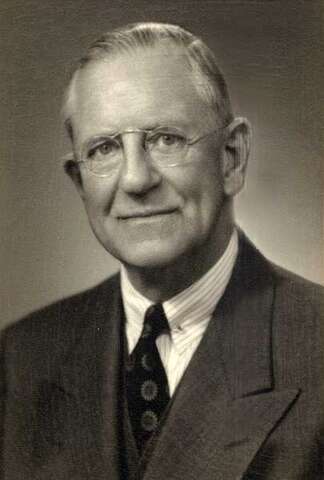
Wright worked in Toronto as a general practitioner until he enrolled in the Canadian Army Medical Corps during the First World War. He pursued postgraduate studies in England and received a Diploma in Ophthalmology from the Royal London Ophthalmic Hospital in 1915. He then worked as an ophthalmic specialist during the war in both England and France. [62]
Wright returned to Canada in 1918 and became a staff of the Department of Ophthalmology at the University of Toronto. He was on staff at the department in the Hospital for Sick Children, where he became Ophthalmologist-in-Chief in 1929.
In 1941 Wright was appointed Ophthalmologist-in-Chief at Toronto General Hospital and Chair of the Department of Ophthalmology for the university.
Wright is considered a pioneer in ophthalmology in Canada, along with Buller and Tooke of Montreal. His largest contribution was the organization of a modern and formalized ophthalmology training program in Canada, initially a shortened course to help physicians within the Armed Forces meet the high demand for train ophthalmic specialists during the Second World War. During that time, the department graduated several ophthalmologists that went to war and then returned to practice in Canada [62].
Wright retired in 1946 [63]. In 1959 the department established at the request of students, residents and colleagues, a Walter W Wright Lectureship, the first of its kind in Canada, which continues today. Records of previous Walter W Wright Lectureships can be found, along with other departmental documents, at the University of Toronto Archives64.
Wright contributed greatly to advances in paediatric ophthalmology. He was a pioneer in the management of amblyopia and strabismus [65]. He worked with William Edward Gallie (1882-1959) in the use of fascia lata in surgical procedures [66]. Wright was the first person to use autologous fascia lata for ptosis repair [62]. The Wright fascia needle is still used today in the frontalis suspension treatment of ptosis.
Wright died in Toronto aged 85 in 1967.
William Herbert Lowry (1880-1942)
William Herbert Lowry was born in Acton, Ontario, as the son of a physician. He graduated from Trinity University, Toronto, in 1901 and completed his postgraduate training in ophthalmology in London and Birmingham, England [59].
Lowry returned to Toronto in 1906 and became staff at the Hospital for Sick Children. In 1929 he was appointed the third Chair of the Department of Ophthalmology at the University of Toronto.
During the First World War, Lowry served in England and Greece as an ophthalmologist in charge of No 4 Canadian Base Hospital and was promoted to lieutenant colonel.
Lowry was a dedicated surgeon and teacher to undergraduate students. He did not do much research but did publish an article on eye injuries in 1930 [60]. Lowry retired as Chair of the department in 1941 for health reasons and died in 1942 of a heart attack while visiting a patient at home.
Alexander Edward MacDonald (1892-1976)
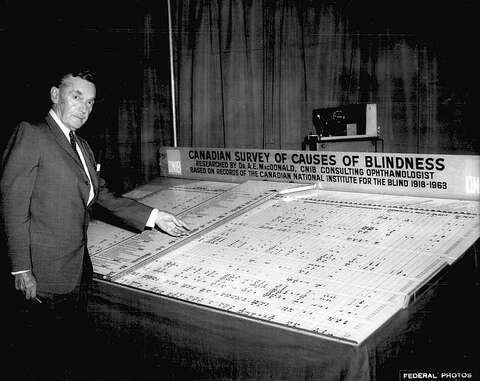
MacDonald was primarily responsible for preparing all of the subsequent ophthalmic pathology specimens and in 1928 lobbied the government and the University for a laboratory dedicated to the subject. MacDonald and Robinson became the primary ocular pathologists for many Canadian provinces and worked together until 1940.[ii]
MacDonald was born in Hepworth, Ontario, in 1892, and was a medical student in Toronto at the beginning of WWI. He went to Europe before completing his training and worked as a corporal in a casualty clearing station. He returned to Toronto to complete his medical degree and then was positioned in France as Lieutenant in the Medical Corps in 1916. He was the first medical officer to cross the German border and reach the Rhine. MacDonald was awarded a military cross by King George V at Buckingham Palace for his efforts.[iii]
MacDonald returned to Toronto in 1919 and worked in pathology. After two years in British Honduras working as a medical officer during a yellow fever epidemic, MacDonald decided to pursue ophthalmology training. He trained in Boston and then in London, England, under Sir John Herbert Parsons (1868-1957) and Sir William Lister (1868-1944). He then completed fellowship training in Graz with Maximillian Salzmann (1862-1954) and Alfred Vogt (1879-1943) in Zurich.[iv]
MacDonald returned to Toronto in 1925 to work at the Toronto General Hospital. He petitioned for $150 in funding and space to set up an ophthalmic pathology laboratory.
During WWII MacDonald was an ophthalmology consultant to the Royal Canadian Navy and helped Wright to set up the postgraduate ophthalmic training program for the military.
MacDonald was the first chairman of the ophthalmic committee of the Royal College of Physicians and Surgeons of Canada and helped to established fellowship examinations. After WWII he became president of the Canadian Ophthalmological Society.
In 1967, MacDonald was awarded the Canadian Centennial Medal for having provided valuable service to Canada.
MacDonald was an authority in cartography. As a student in Paris he purchased a 16th century map of the Great Lakes, the first of a collection depicting the mapping of Eastern North America. In 1958 the Royal Ontario Museum held an exhibition of early cartography entitled "Up North – The Discovery and Mapping of the Canadian Arctic" from MacDonald's private collection[v].
MacDonald died in 1976 and his most significant legacy is his bequest to the Department of Ophthalmology of payments his estate received from the sale of his cartography collection to the Public Archive in Ottawa in 1981[vi]. The A.E. MacDonald Ophthalmic Library was named in his honour. The residue of his estate continues to support the ophthalmic library and ophthalmic research at the University of Toronto.[vii]
Further reading:
- AE MacDonald's Curriculum Vitae (PDF 360KB)
